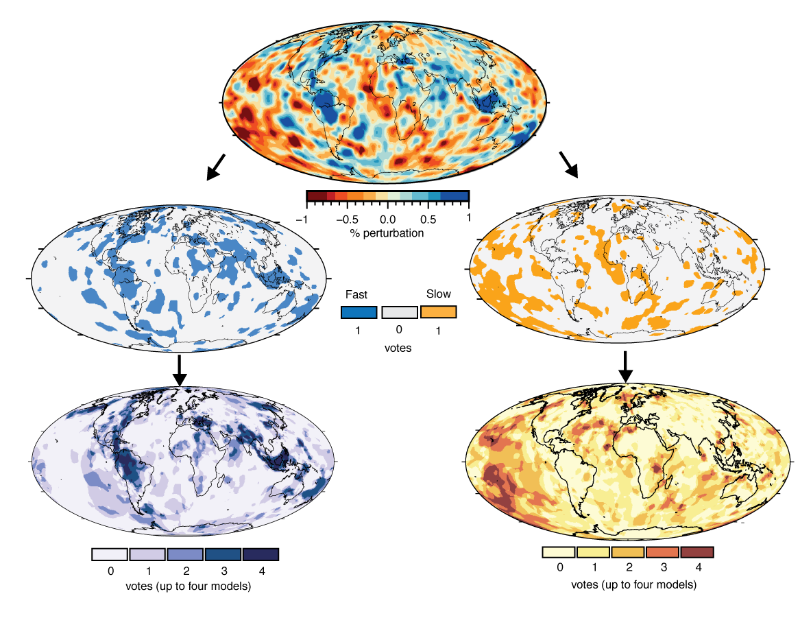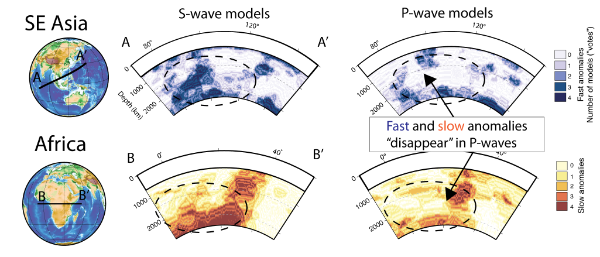A quick spin around chemistry and physics
Ferropericlase is the second most abundant mineral in the Earth’s rocky lower mantle (660-2900 km depth). One of the key building blocks of this mineral is iron, and is one such element that can have a "spin" property. Very simply, the iron spin cross-over is related a change in the quantum state of an electron (here specifically for Fe2+ in ferropericlase) from a high-spin to low-spin state with increasing pressure inside the Earth (increasing depth). In other words, at some depth all Fe2+ will be in a high-spin state and at a greater depth all Fe2+ will be in a low-spin state; the cross-over is a region where both states exist. Nearly 60 years ago a spin cross-over in iron was predicted by theoretical physics, and around 30 years ago, it was proven with high pressure laboratory experiments. However, it since has dodged clear detection in geophysics data.

Finding the iron spin crossover is important for understanding the evolution the Earth because, for example, it affects the dynamics of sinking slab of oceanic lithosphere and rising plumes. It also holds implications for the bulk composition of the Earth and its evolution since planetary formation. As such, it is a topic that is relevant for anyone studying the chemical, thermal, and dynamics of the Earth.
Numerous scientists and groups have worked on understanding and elucidating the spin crossover throughout the decades. Fortunately, the spin state change (in iron in ferropericlase) has a number of predictions that can be further examined. For instance, that the high-to-low spin cross-over:
1. is predicted to occur at conditions around 1500 km depth,
2. it exhibits a temperature dependence, and
3. affects the bulk modulus (a material's resistance to compression) but not the shear modulus (a material's resistance to shear), and therefore holds implications for the propagation of different seismic waves.
Earlier work found clear hints that something unusual is happening in the mid-lower mantle. For example, based on seismic images, slabs and plumes seemed to be disrupted, disappearing or stalling. However, a clear link to the predictions of the iron spin cross-over was still missing. In particular, one challenge was that when looking at a global average of seismic velocities, there was no clear signal of the predicted cross-over. This questioned whether the cross-over exists in ferropericlase, to what extent it affects material properties, and/or how abundant ferropericlase really is. However, this line of questioning also hinted that different regions of the mantle needed to be investigated individually.
By developing a new, cross-disciplinary lens with which to look at the data did researchers from Norway, Tokyo and the USA find "the smoking gun" for the iron spin cross-over.
Finding the signal in seismic tomography.
Seismic tomography is one of the best methods geoscientists have to image the Earth's insides today. It uses waves generated by earthquakes and recorded at global seismographic stations to map the interior. The images reveal material that propagate these two kinds of seismic waves faster or slower than the average. Cold, downwelling slabs of oceanic lithosphere are typically imaged as fast seismic anomalies (often depicted with blue colours) and hot, upwelling mantle plumes as slow seismic anomalies (red colours) (Figure 2).

The researchers investigated the varying behaviour of the spin crossover for P-waves and S-waves, two distinct kinds of seismic waves that propagate through the Earth. As mentioned, seismic images have long shown a discrepancy between P- and S-wave images at mid-mantle depths, especially in the regions charaterised by elevated seismic velocities. In particular, the P-wave signatures of prominent fast features become muted in comparison to their S-wave counterparts (Figure 1 panel b). As it turns out, exactly this kind of behaviour is expected for rock containing plausible amounts of ferropericlase at mid-mantle conditions. The ferropericlase spin crossover involves volume decrease and softening, related to the bulk modulus decrease. The crossover interval starts at a deeper level and broadens over a wider depth and pressure range at higher temperatures. When they looked for this signature in seismically slow regions, corresponding to higher temperatures (Figure 1 panel c), they again found evidence for a weakening of P-wave, relative to S-wave features at a greater depth, as predicted. This signals match those of the mineral physics calculations ("Onset" in Figure 1).

Earlier work by lead author Grace Shephard involved looking at different tomography models produced by the seismology community, and searching for the most common features through "vote maps". The results shown in this latest paper were found to hold across individual models but were best illuminated when looking at the eight different models (4 P-waves and 4 S-waves) collectively through the vote maps (Figure 1).
Small atoms, big implications.
The absence of the effects of a spin crossover in globally averaged seismic profiles of the Earth’s mantle suggest that large scale changes in chemical composition may be necessary. One such possibility is the presence of massive regions in the mid-mantle containing rocks that have little ferropericlase (and therefore leading to no visible signature of a spin crossover). Members of the same team proposed the presence of such features in the mid-mantle, which anchor the pattern of the Earth’s deep mantle convection and persist over billions of years owing to their high strength and resistance to convective flow. They called these “bridgmanite-enriched ancient mantle structures” or BEAMS (bridgmanite is the most abundant mineral in the Earth, and is also the strongest), and speculated that they may exert a fundamental control on the pattern of tectonic plate motions over Earth’s history. However, this is just one possibility. Beyond detection of the cross-over, this study also goes to show the strength of interdisciplinary collaborations. There are many exciting advances that are still to be made in understanding the deep interior.
Contact: Grace Shephard. Email: grace.shephard@geo.uio.no
Publication details: Shephard, G.E., Houser, C., Hernlund, J.W. Valencia-Cardona, J.J., Trønnes, R.G., Wentzkovitch, R.M. Seismological expression of the iron spin crossover in ferropericlase in the Earth’s lower mantle. Nat Commun 12, 5905 (2021). https://doi.org/10.1038/s41467-021-26115-z
You can also plot tomography models and vote maps at the SubMachine website.
The project is a collaboration between two university research institutes devoted to understanding related aspects of the evolution of Earth and life: the Center for Earth Evolution and Dynamics (CEED, University of Oslo) and the Earth-Life Science Institute (ELSI, Tokyo Institute of Technology). CEED and ELSI are both specially supported by national initiatives of the governments of Norway and Japan (respectively) to achieve scientific breakthroughs by bringing together scientists from a variety of disciplines and adopting novel strategies for research.




